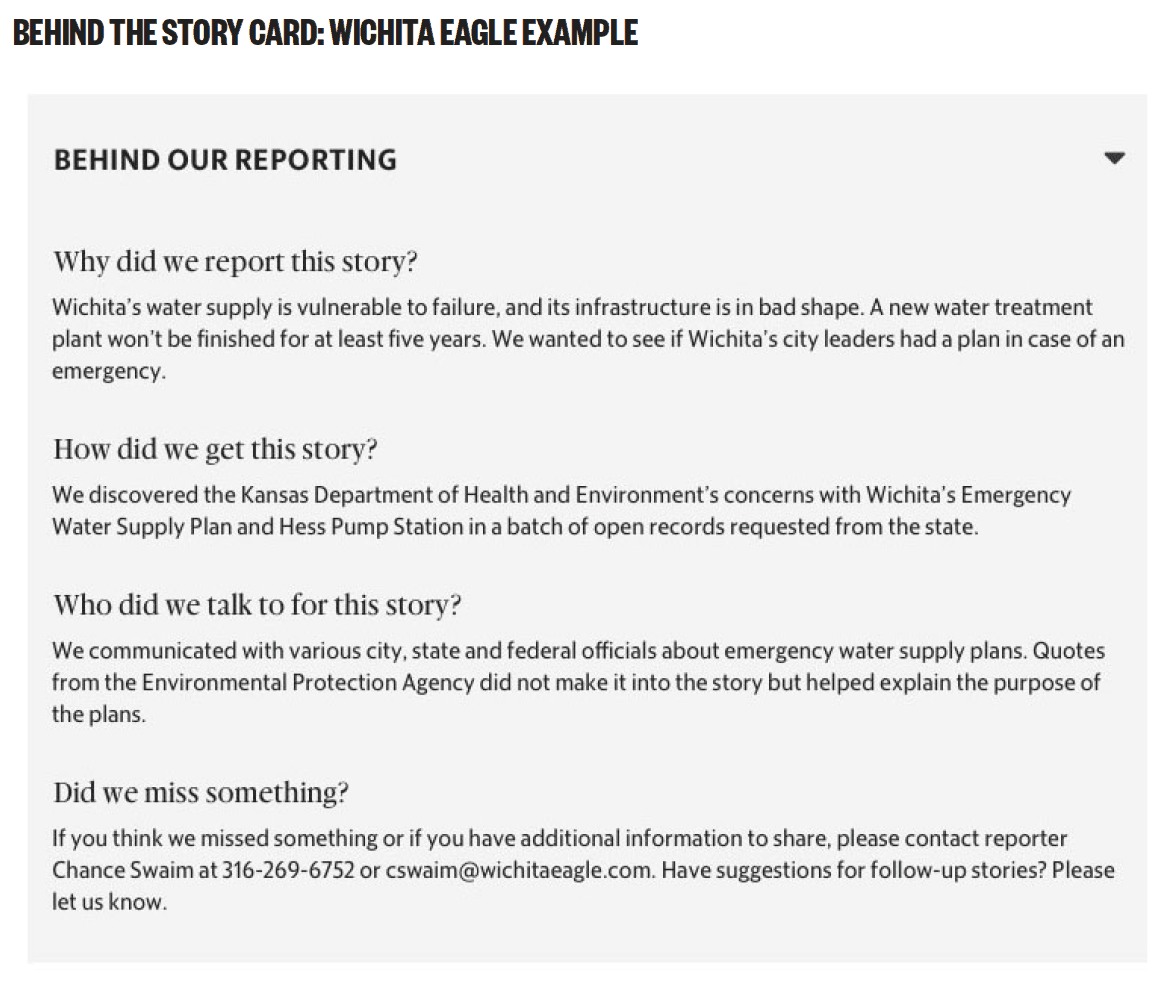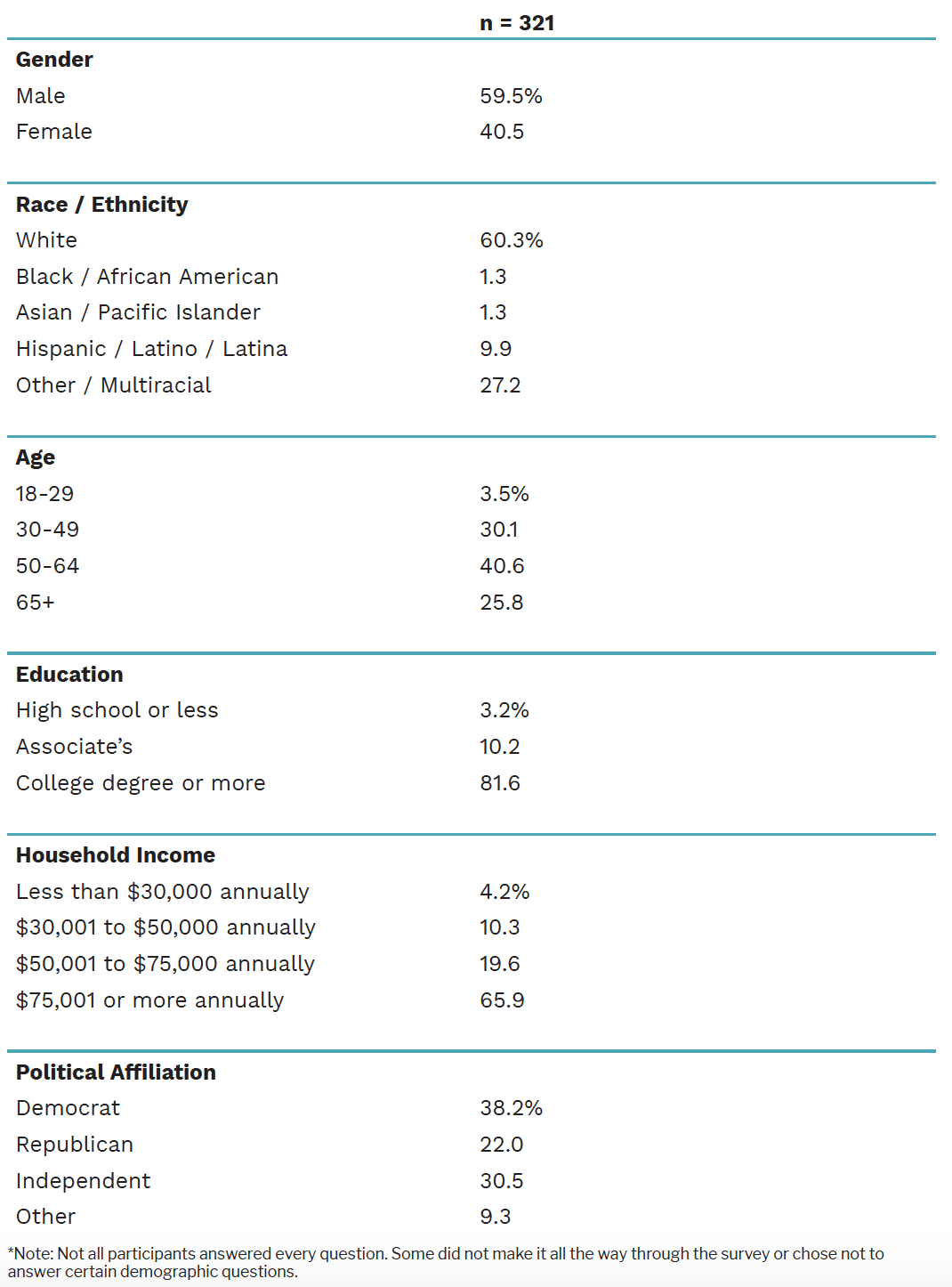
Inspired by previous research conducted by the Center for Media Engagement and Trusting News, a team at McClatchy designed a Behind the Story card that provides information about why and how a story was written. The card can include who journalists talked to for a story, why the topic is important, and the reasoning behind their reporting choices, among other details. In this study, we explored whether the placement of the Behind the Story card on a news organization’s website affected readers’ recall of the card and trust in news. When we just showed people a Behind the Story card, most readers said that the card would increase their trust in a news organization.
When the Behind the Story card was embedded within an article, however, the majority of readers did not notice it. Non-subscribers did notice the card more often when it was placed in-line with a news article’s text than when it was placed at the bottom of the article, but neither the placement nor the presence of the Behind the Story card affected audience trust. Overall, the study suggests that using a card designed to improve transparency may positively affect trust, but newsrooms need to make sure it’s noticeable.
The Problem
Previous research from the Center for Media Engagement showed that less than ten percent of readers in three communities thought that their local newsrooms adequately explained how and why they decide what stories to cover. And both journalists and readers don’t always rate their news organizations as very transparent. Features like McClatchy’s Behind the Story card may help to address this perceived lack of transparency and help readers to understand the reporting process better.
In a previous study, we tested a box designed to explain the process of reporting a story and found that it improved trust. Using this work as inspiration, McClatchy designed a Behind the Story card. In this experiment, funded by a grant from the Democracy Fund, we looked at whether the placement of the Behind the Story card on a news organization’s website could influence readers’ recall of the card and trust in news.
Key Findings
- When shown a Behind the Story card outside the context of an article, a majority of readers said the card would improve their trust in a news organization.
- Although the Behind the Story card appealed to most readers, a majority of readers did not notice it, and its presence within an article did not affect trust in the news organization.
- Non-subscribers noticed the Behind the Story card more often when it was placed in-line with the article text than when it was placed at the bottom of the article.
Implications for Newsrooms
Readers reported that a Behind the Story card featuring information about how and why a story was written would increase their trust in news organizations. This is in line with findings from our previous research on boxes that explain the story process. In this experiment, however, few readers noticed the card on the page when it was included in the article. This indicates that, while the contents of the card may be valuable to readers, newsrooms need to ensure that it is highly visible. Newsrooms and researchers should continue testing different designs that could draw readers’ attention to trust and transparency efforts.
The Study
For this experiment, the Center for Media Engagement partnered with three McClatchy newsrooms: The Wichita Eagle, El Nuevo Herald and The Sacramento Bee. Audience members from the three outlets read an article from their local newspaper that either featured a Behind the Story card placed in-line with the text, a card placed at the bottom of the article, or an article without a card. After seeing the article, participants answered questions about their levels of trust and engagement. All participants then viewed and answered questions about a Behind the Story card outside the context of an article.
 When viewing a BtS card embedded within an article, a majority of participants had no recollection of seeing it. Overall, 33.7% of people said they remembered seeing a section titled “Behind our Reporting” when the card was placed in-line, compared to 21.2% of people who remembered when it was placed at the bottom of the page, and 8.4% of people who remembered when it was not present on the page. Although a higher percentage of people noticed the BtS card when it was placed in-line, this difference is not statistically significant from the card appearing at the bottom of the article.1
When viewing a BtS card embedded within an article, a majority of participants had no recollection of seeing it. Overall, 33.7% of people said they remembered seeing a section titled “Behind our Reporting” when the card was placed in-line, compared to 21.2% of people who remembered when it was placed at the bottom of the page, and 8.4% of people who remembered when it was not present on the page. Although a higher percentage of people noticed the BtS card when it was placed in-line, this difference is not statistically significant from the card appearing at the bottom of the article.1
When participants were asked to rate the trustworthiness of the article, the news organization or the reporter, whether people saw an article with a BtS card or not didn’t significantly change their ratings.2 It also did not matter whether the BtS card was placed inline or at the bottom of the page.3 The lack of differences is possibly due to the fact that few people reported noticing the card, even in articles where it was present.
We evaluated whether there were differences in recall of the card depending on people’s demographic attributes, political orientations, and media habits. Only one difference emerged: Subscribers were more likely to recall the BtS card when it was in-line (29.6%) or at the bottom (30.6%) compared to when it did not appear (10.0%).4 Non-subscribers, however, were more likely to recall the card when it appeared in-line (40.0%) than when it appeared at the bottom (8.3%) or did not appear at all (5.9%).5
These benefits are small but encouraging. Future research could evaluate whether the content of the Behind the Story card or other design choices besides page placement could enhance the likelihood of readers noticing the card and perhaps more definitively move the needle on trust.
Methodology
We recruited 321 participants from the audiences of three McClatchy news websites: 111 from The Wichita Eagle, 158 from The Sacramento Bee and 52 from El Nuevo Herald. Researchers created three Qualtrics-based online surveys, one for each newsroom. The three surveys were identical aside from the article and the Behind the Story card; participants were shown an article and card from their local news organization. The newsrooms each posted a call-out on their website and social media accounts to ask their readers to participate.
We combined the participants from all three newsrooms for our analysis. We tested for differences using ANOVA and chi-square statistics.
Participant Demographics*
SUGGESTED CITATION:
Murray, Caroline and Stroud, Natalie Jomini. (2020, January). Testing behind the story cards. Center for Media Engagement. https://mediaengagement.org/research/behind-the-story-cards
- We tested for differences using a chi-square statistic, which was statistically significant χ2(2) = 17.83, p < .05. [↩]
- We tested for differences using ANOVA. There was no significant effect of condition for the ratings of the news organization, F(2, 270) = 0.290, p > .05, the article, F(2, 270) = 0.762, p > .05 or the reporter, F(2, 270) = 0.204, p > .05. [↩]
- There was some evidence that the presence of a BtS card increased trust in the article and news organization among those not identifying with a mainstream political party, but the sample size is small (n=103), so this should be taken as only suggestive evidence requiring additional analysis. [↩]
- We tested for differences using a chi-square statistic, which was statistically significant χ2(2) = 8.74, p < .05. [↩]
- We tested for differences using a chi-square statistic, which was statistically significant χ2(2) = 17.07, p < .05. [↩]




